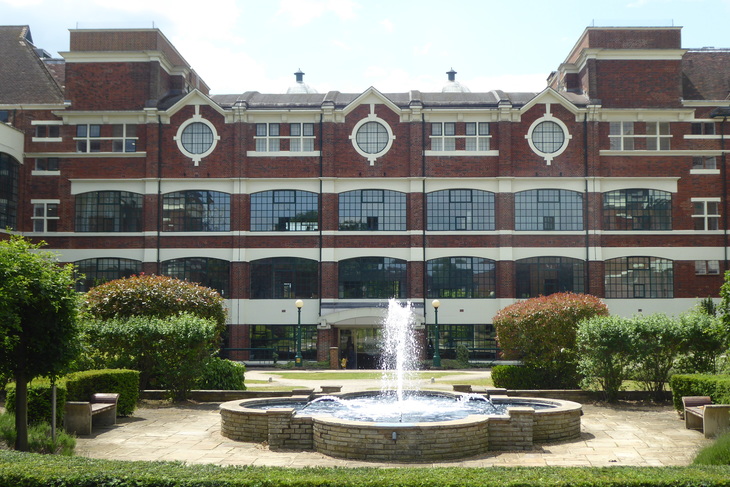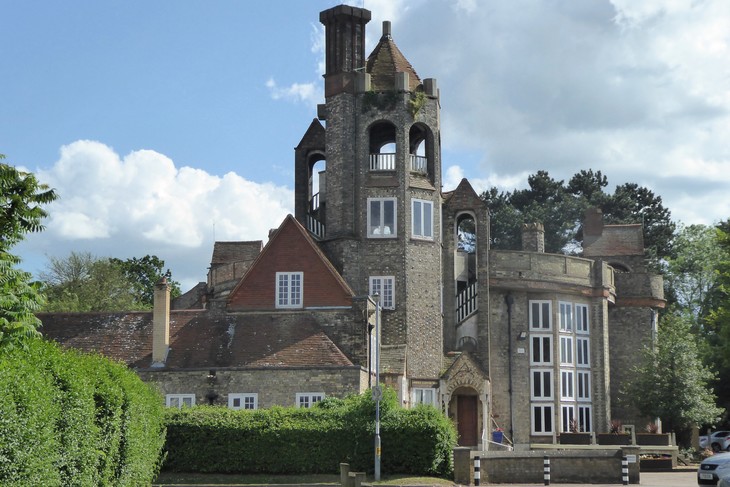
“All the advantages of the most energetic and active town life with all the beauty and delight of the country”. That was the pitch from Ebenezer Howard, a Victorian visionary who dreamed in 1898 of evacuating urban folk from noisome, crowded cities to purpose-built settlements. The world’s first such garden city, Letchworth, promised its residents space and a separation of factories from homes.
While Howard’s words sound like the outdated advertising they now are, his experiment in town planning still strikes a chord for many. Letchworth Garden City is as little as 27 minutes by train from King’s Cross and continues to receive plenty of London defectors. Most of us who stay in the Big Smoke will never stain our fingers while gardening, be woken up by a cockerel, or enjoy localler-than-local fruit and veg in our nearest restaurant. London offers greenery, but little that’s rural.
As for LGC, it promised work-life balance and a nice place for workers to live: concerns that top many Londoners’ agendas today. Are such needs still provided for? Are those who are moving here on the cusp of a trend? And while Letchworth’s design principles are partly accountable for every horrendous village-style housing development ever made in Britain, do we need more garden cities?
"We enjoy London more than ever now"

“I've always suffered from anxiety,” says Sarah Graham. “And towards the end of my time in London, I was not coping well with things like the tube and crowded places.” A journalist and creator of the Hysterical Women blog, Sarah is one of those still drawn to Howard’s manifesto of ditching the capital for a more nurturing lifestyle in Letchworth’s greenery. For her, LGC has more than delivered.
“My husband and I haven't heard a siren in two weeks,” she says. “At night time you can see the stars. Or you’ll be lying in bed on a Sunday morning, and the only sound is birds tweeting and kids playing football. Simple things like that have boosted our wellbeing in ways we hadn’t expected.”

To hell with Samuel Johnson’s mantra that “he who is tired of London is tired of life”. Every place in Britain might be improved if we were as aware as Sarah about where’s right for us to set up home. After all, a reluctant Londoner benefits no one. They hate being on the Central line and everyone else hates them being on the Central line just because their entire industry is centred in a square mile around Bank station. (But the over-centralisation of the country is one for another article.)
“A few people have made comments about us being old and dull now,” Sarah reflects. “But we’ve embraced it. And now, we probably go to the theatre and meet friends in London more than ever just because I don't feel so stressed by it.” As one of a growing number of freelance home-workers not condemned to a daily commute, Sarah is pretty true to the garden-city dream of a self-supporting community. Thanks to the internet, her life happens more or less fully within the town.
"We’ve got the young people on board"

100 years before the hipsters of Hackney there were the liberals of Letchworth. Several vegetarian and vegan businesses dotted across the town centre in 2019 are a callback to the free-thinkers of the early 20th century. In spirit, each of them was that friend of yours who really wants to quit their job and become a yoga instructor if only they knew how. Except this lot really went ahead and did it.
Londoners were said to have journeyed here to point and laugh at these Edwardian weirdos in their Arts & Crafts houses. Letchworth was so Lefty that Lenin himself once visited, according to urban myth. In 1937, George Orwell passed through the town and wrote scathingly about “the typical Socialist [...] with vegetarian leanings” whose doctrines attracted “every fruit juice-drinker, nudist, sandal-wearer, sex-maniac, Quaker […], quack, pacifist, and feminist in England.”
We can only imagine what Orwell might have made of a nut and hempseed burger — but this and other popular dishes are served by Sam Carman at the meat-free Nourish Cafe. “Yes, people did look at Letchworth as being a bit hippy-dippy,” she says. “I remember that when I was growing up here. But we don’t get any stick nowadays for wearing sandals and socks,” she laughs. “I think that’s because we’ve now got the young people on board with vegetarianism and veganism. And we’re getting a lot of first-time buyers coming to Letchworth from London.”
A new health-focused community springing up outside the filthy city: it sounds like a case of history repeating itself. But what is it that makes this corner of Hertfordshire so special? We ask the founder of the Letchworth Centre for Healthy Living, housed in a former cottage hospital on pleasant greenbelt.
“When people come here, they often express their experience of the healing environment that they find around here,” says Roberta Meldrum. “They get almost as great a benefit from the tranquillity of this site, and Letchworth, as from the treatments we offer. That is an expression of what Ebenezer Howard was trying to do. We are just an illustration of what he articulated many years ago.”
The garden city principle

For Letchworth, wellness and tidiness go hand in hand. Forget glassy modern buildings or even kooky street art in a such a pristine place as this. To wander the streets is to build the impression of a fastidious man haunting the town with a little pair of scissors and a ruler. Hedgerows are pruned to an inch-perfect height, beautiful flowers adorn the purported first roundabout in the world, and everything is just so. Much of the careful maintenance is down to LGC’s Heritage Foundation.
It’s there to help uphold a pleasant urban-rural balance. This much we learn at Standalone Farm: one of the area’s big tourist draws, and just one small part of the Foundation’s estate. It’s a strangely affirming experience to be able whiff some farmyard smells and hear the oinking of pigs after just a short hop from the railway station — itself just a quick train ride away from London. We’re told that families visit here from plenty of other urban areas all over the world, too.

“A lot of children who come here may not understand the concept of chickens laying eggs, and that this is where you get your food from,” says the Foundation’s Jo Burnham. “So this farm does as much as possible in education.” Letchworth is said to be unique not only for blending town and country, but for having a charitable organisation behind it. Whether it’s in buses, cinemas, or this family-friendly farm, the Heritage Foundation can still invest when council funding has dried up.
Its other role, as Jo puts it, is to act as a “custodian of the garden city principle”. That means changes to the town’s oldest buildings must be signed off by heritage experts. Controlling this may be, but such efforts to preserve the Letchworth’s character have so far mostly prevented it from looking like Just Another Home Counties Town.
Booze-free boozers

It is easy to assume this place is the embodiment of ‘organised fun’. And the contest to be the wildest place in North Hertfordshire is not exactly a competitive one. Letchworthians tell you their town has more going for it than Welwyn — a rival garden city — but lacks the buzzing nightlife of, erm, Hitchin. LGC was built with just one pub — the blandly-named Skittles Inn of 1907 — which was po-faced and booze-free. So it’s ironic that the recent sci-fi film The World’s End, about a pub crawl gone apocapyptically awry, was shot in this town which lacks decent watering-holes to this day.
But with lip-smacking craft beers on tap, Garden City Brewery bucks the century-old teetotal trend. “When we opened, people told us Ebenezer Howard was against drinking,” says Holly Rolfe, the co-owner. “Actually, he wasn’t against drinking, he was against drunkenness. And we are a very relaxed place. We avoid big groups of blokes who just want to have pints of Foster’s and Jägerbombs.”
The temperance brigade long gone, by 2016 authorities were actively encouraging this brew-pub to open up - because it would form a new community hub and buy local ingredients to boost sustainability. “There’s a certain kind of person in Letchworth,” Holly explains. “They’re maybe a bit more chilled, a bit more arty. Not everyone is an eco-warrior — but like us, they’ve got that slant.” What about Orwell’s description of Letchworth’s Socialists, vegetarians, and oddballs? “I think there is a slice of the community that is like that, which is nice. It gives you a core of originality.”
"I would live in Cornwall if I could"

The LGC philosophy (roomy houses, wide streets, lawns spilling everywhere) has been imitated in purpose-built settlements in Britain and beyond. When replicated in London suburbia, its utopian aims have been misappropriated for some of the most miserable pastiche architecture and inefficient urban planning seen anywhere on the planet. Dog-fouled and glass-laced grass verges, poorly-made pattern-book houses, and over-developed green spaces: all these fill our streets from Bromley to Brent, and reveal that garden city ideas cannot simply be applied willy-nilly.
Yet the fates of Letchworth and London remain closely entwined. Laura Snapes, the Guardian’s deputy music editor, moved from the capital to LGC to live with her partner John Allison, a comic book writer and artist. He admits that he chose the place “more or less with a pen” and after some research on Mumsnet; she admits, “I would live in Cornwall if I could, but I can’t do my job there.”
It was a move perhaps born of compromise rather than a draw towards what’s left of Letchworth’s original town-meets-country vision. Laura and John’s words reveal how far a planned settlement can stray away from its original promise. Inevitably, Letchworth has become defined by London. “At some point, in the last 114 years, it’s become a Tory commuter hotbed,” says Laura. “If people are talking about building more garden cities and they want to get back to Socialist principles, with lots of space and integration, then great. But otherwise, I don't really know what they're talking about.”
“Just don’t build more commuter towns to steal more hours from people’s lives,” is the lesson John has learned. “Put houses where they need to be. If you're not going build a science park, and then houses, shops and schools around it, then what is the point?”

But while the pair are ambivalent towards what LGC has become, they say it doesn’t deserve to be judged quickly. “If you’re the kind of person that enjoys going on the Barbican architecture walking tour, you can have a nice day out here, ogling all the Arts & Crafts houses and the world’s first roundabout,” says Laura. “You can do it for hours”, adds John. “You can walk around saying look at this and that. Letchworth is rich in that way. It shouldn’t be somewhere people say ‘where’s that?’”
Successive governments have promised new garden city-style settlements to solve the housing crisis, but in many cases, it remains to be seen exactly what they envisage. Strolling down Broadway — Letchworth’s loveliest, leafiest, widest street — is enough to confirm that many of Howard’s ideals no longer have a place in modern urban planning. Put simply, there is no more space for a proper garden city, and why water down a concept that was successful a century ago instead of coming up with something fresh? But although we need to move on from his idea, we could use a dose of Howard’s pioneering spirit. Not to mention a glass of whatever booze-free drink he was ordering.
.



